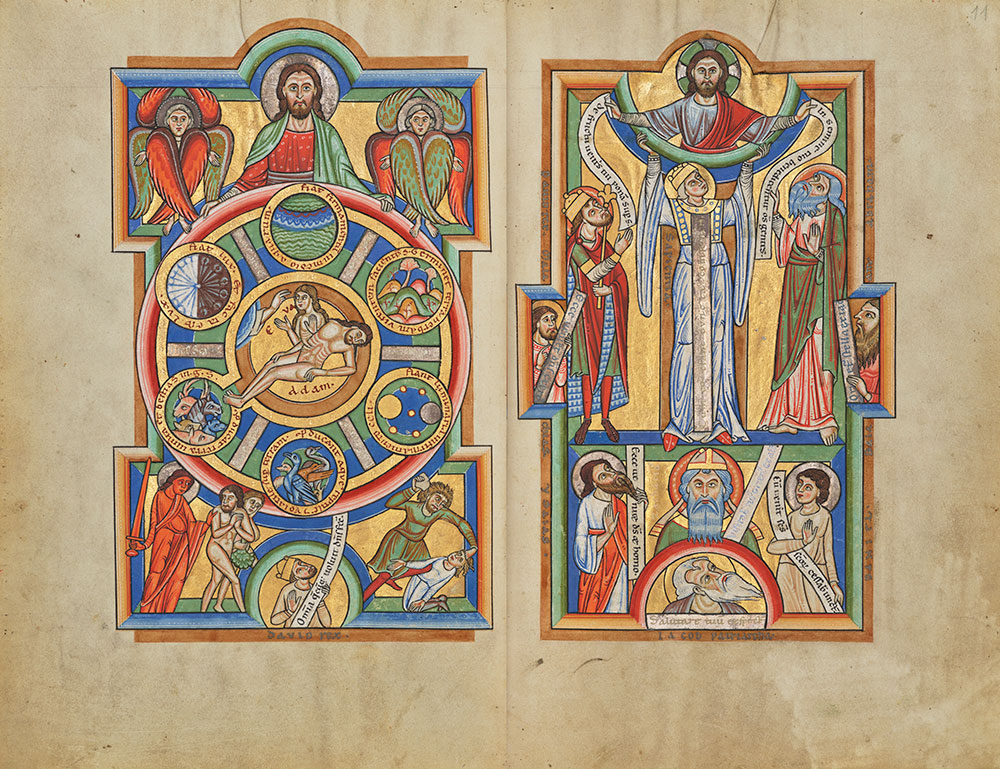
THE MONASTIC SCRIPTORIUM
In the twelfth century, monks at the Benedictine monastery of St. Michael advocated for the canonization of their founder, Bishop Bernward of Hildesheim (d. 1022). These efforts coincided with a flurry of artistic activity, including the production of spectacularly illuminated manuscripts—among them, this missal. By depicting the story of salvation, the prefatory cycle shapes viewers’ understanding of the manuscript’s contents. The radially organized Creation miniature, at left, focuses on the plight of Adam and Eve, who are encircled by representations of the six days of Creation. Their expulsion from paradise and the story of Cain and Abel, below, indicate the sinful state of humankind. The facing miniature, in contrast, represents the promise of salvation. At center, a personification of divine wisdom holds up Christ amid Old Testament figures who prophesize his incarnation.
"Stammheim Missal,” in Latin
Germany, Hildesheim, ca. 1170
J. Paul Getty Museum, Los Angeles, MS 64, fols. 10v–11r
Purchased by the J. Paul Getty Museum, 1997
Joshua O'Driscoll, Assistant Curator of Medieval and Renaissance Manuscripts
Around the middle of the twelfth century, monks at the Benedictine monastery of St. Michael at Hildesheim, in Lower Saxony, were advocating for the canonization of their famed eleventh-century founder—Bishop Bernward, who was a great patron of the arts as well as the tutor of Emperor Otto III. As part of this effort, the monks initiated a flurry of artistic activity that included building renovations and the production of spectacularly illuminated manuscripts such as this mass book, known as the Stammheim Missal. With fifteen full-page paintings and well over a dozen half-page decorative initials, this manuscript is among the most sophisticated and richly illuminated books of its time.
After a splendid calendar, the Stammheim Missal opens with a prefatory cycle of three miniatures depicting Creation, Divine Wisdom, and the Annunciation. The complex compositions of this opening cycle provide the viewer with a theological framework for understanding the contents of the manuscript. The first miniature, at left, focuses on the creation of Eve from Adam’s side. Around them are the six days of Creation. The scenes below depict their expulsion from Paradise and the subsequent story of Cain and Abel, both indicative of the sinful state of humankind.
If the first miniature emphasizes the Fall from Grace, the facing page represents the promise of salvation. At center, a personification of Divine Wisdom holds up a figure of Christ. They are surrounded by Old Testament kings, prophets, and patriarchs. Taken together, these figures present the coming of Christ as the fulfillment of Old Testament prefigurations. On the next page, Christ’s incarnation is depicted with the miniature of the Annunciation.
This approach of presenting events from the Christian New Testament as the fulfillment of prophecies from the Hebrew Bible is known as typology, and it was a central feature of monastic art in the twelfth century.
